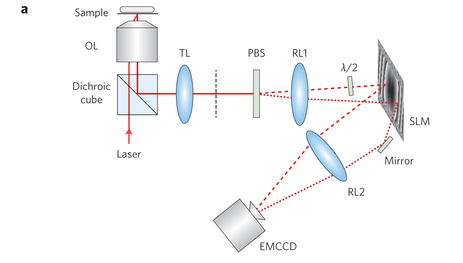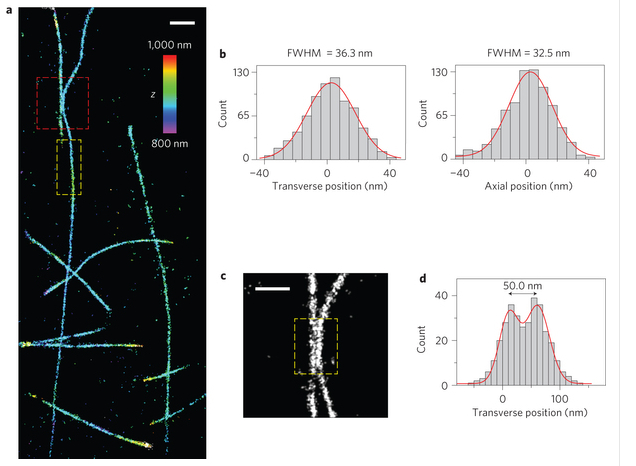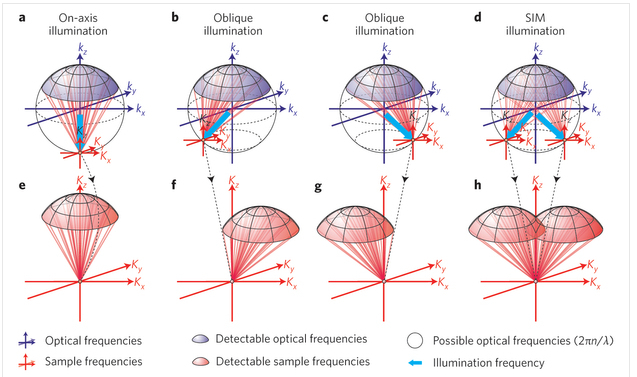一、本期重点:
1.使用自弯曲点扩散函数的各项同性三维超分辨成像(Isotropic three-dimensional super-resolution imaging with a self-bending point spread function)【Nature Photonics】
doi: 10.1038/nphoton.2014.13
published:2014.3.2
内容介绍:
艾里光束长距离传播不会产生显著衍射,同时有会产生侧向弯曲的特性。文章使用了基于艾里光束的自弯曲点扩撒函数实现超分辨成像。定位精度10-15nm,成像深度3μm左右。图一是实验系统的示意图,样品经物镜和筒镜形成实像面被单光子CCD接收,空间光调制器将光束调制为自弯曲点扩散函数。图二是将自弯曲点扩散函数应用在STORM技术中观察到的细胞微管图。


图二 利用自弯曲点扩散函数使STORM方法观察到的微管图
doi: 10.1038/nphoton.2014.88
published:2014.4.25
内容介绍:
结构光照明技术在超分辨成像中得到了很多应用,有一种观点认为在不使用倾斜照明的情况下,结构光照明并不能实现真正的突破阿贝衍射极限的超分辨成像。文章通过仿真和讨论最后得出,在相干结构光照明的成像中,并没有提供多于阿贝衍射极限的更多的成像信息,即使在部分文章中提到了图像对比度等的提高。但在非相干的结构光照明的成像中,由于相位信息的丢失,通过对强度信息的分析,却能得到更多的信息。

图三 不同的相干照明方案中可探测到的频率信息示意图
二、简讯:
doi: 10.1364/OE.22.012339
published:2014.5.13
Abstract:
We have developed a technique for imaging dark, i.e. non-radiating, objects by intensity interferometry measurements using a thermal light source in the background. This technique is based on encoding the dark object’s profile into the spatial coherence of such light. We demonstrate the image recovery using an adaptive error-minimizing Gerchberg-Saxton algorithm in case of a completely opaque object, and outline the steps for imaging purely refractive objects.
doi: 10.1364/OE.22.012691
published:2014.5.16
Abstract:
We report on a direct-write system for patterning of arbitrary, high-quality, continuous liquid crystal (LC) alignment patterns. The system uses a focused UV laser and XY scanning stages to expose a photoalignment layer, which then aligns a subsequent LC layer. We intentionally arrange for multiple overlapping exposures of the photoalignment material by a scanned Gaussian beam, often with a plurality of polarizations and intensities, in order to promote continuous and precise LC alignment. This type of exposure protocol has not been well investigated, and sometimes results in unexpected LC responses. Ultimately, this enables us to create continuous alignment patterns with feature sizes smaller than the recording beam. We describe the system design along with a thorough mathematical system description, starting from the direct-write system inputs and ending with the estimated alignment of the LC. We fabricate a number of test patterns to validate our system model, then design and fabricate a number of interesting well-known elements, including a q-plate and polarization grating.
doi: 10.1364/OL.39.002853
published:2014.5.6
Abstract:
We propose a new multi-projection integral imaging scheme using a convex mirror array. In the proposed scheme, to overcome the resolution limitation of the conventional method due to observing the single aperture imaging point (AIP) from each convex mirror, we introduce the multi-projection to obtain multiple AIPs per convex mirror so that the viewer observes the resolution-improved 3D reconstructed images. We validate the theoretical analysis of the proposed scheme and confirm its feasibility through the optical experiments. To our best knowledge, this is the first report to generate multiple AIPs per convex mirror in a projection integral imaging system.
doi: 10.1364/OL.39.002896
published:2014.5.8
Abstract:
We report on the assembly of an off-axis reflective imaging system employing freeform, φ-polynomial optical surfaces. The sensitivity of the system to manufacturing errors is studied for both a passive and active alignment approach. The as-built system maintains diffraction-limited performance in the long-wave infrared.
供稿:王恒







